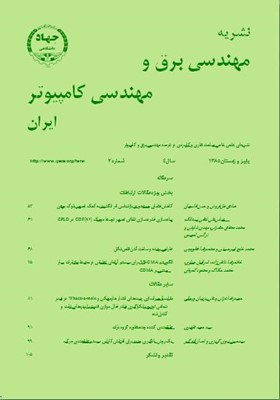ارائه يک روش تحليلي براي بررسي عملکرد ديکدينگ تکراري کدهاي LDPC منظم در کانالهاي AWGN
محورهای موضوعی : electrical and computer engineeringحسین صمیمی 1 , پائیز عزمی 2 , محمد حکاک 3
1 - مرکز تحقیقات مخابرات ایران
2 - دانشگاه تربيت مدرس
3 - دانشگاه تربیت مدرس
کلید واژه: كدهاي LDPCديكدينگ تكراريمدل گوسيالگوريتم جمع- ضربآستانه نويز,
چکیده مقاله :
هدف از نگارش اين مقاله ارائه يك روش تحليلي براي بررسي عملكرد فرآيند ديكدينگ تكراري كدهاي LDPC هنگام استفاده از الگوريتم انتقال پيام ميباشد. پيامهاي مبادلهشده در الگوريتم انتقال پيام را ميتوان به صورت متغيرهاي تصادفي با توزيع گوسي مدل نمود. در اين مقاله روش تقريبي جديدي براي محاسبه پارامترهاي آماري اين متغيرهاي گوسي پيشنهاد شده است. بر مبناي روش پيشنهادي، روابط تحليلي مناسبي به فرم بسته توسعه يافتهاند و به كمك آنها يك مدل تحليلي براي بررسي فرآيند ديكدينگ تكراري كدهاي LDPC پيام ارائه شده است. مدل پيشنهادي ابزار مناسبي براي تحليل فرآيند ديكدينگ كدهاي LDPC است و ميتوان از آن جهت تعيين پارامتر آستانه نويز، بررسي نحوه انتشار خطا و نيز بررسي همگرايي ديكدينگ تكراري استفاده نمود. مقايسه نتايج حاصل از بكارگيري مدل تحليلي پيشنهادي با نتايج حاصل از روشهاي موجود، نشاندهنده آن است كه روش پيشنهادي با حجم محاسباتی قابل قبول به دقتي بيش از روشهاي موجود دست مييابد.
In this paper we propose a new Gaussian-based analytical method for performance analysis of regular LDPC codes iterative decoding on AWGN channel. The proposed method has good accuracy and low complexity in comparison with current methods. Based on our developed analytical equations, we present an error propagation model for the iterative decoder of LDPC codes which can be used as a simple tool for convergence analysis of LDPC codes on the AWGN channel.
[1] C. E. Shannon, "A mathematical theory of communication," Bell System Technical J., vol. 27, pt. 1, pp. 379-423, Jul. 1948, pt. 2,pp. 623-656, Oct. 1948.
[2] J. C. Mackay and R. M. Neal, "Near Shannon limit performance of low density parity check codes," Electronics Letters, 32:1645-1646, Aug. 1996.
[3] R. G. Gallager, Low-Density Parity-Check Codes, Cambridge, MA:MIT Press, 1963.
[4] T. J. Richardson, M. A. Shokrollahi, and R. L. Urbanke, "Design of capacity approaching irregular low-density parity-check codes," IEEE Trans. Inform. Theory, vol. 47, no. 2, pp. 619-637, Feb. 2001.
[5] S. Y. Chung, G. D. Forney Jr., T. J. Richardson, and R. L. Urbanke,"On the design of low-density parity-check codes within 0.0045 dB of the Shannon limit," IEEE Commun. Lett., vol. 5, no. 2, pp. 58-60,Feb. 2001.
[6] F. R. Kschischang, "Codes defined on graphs," IEEE Commun. Mag., vol. 41, no. 8, pp. 118-125, Aug. 2003.
[7] T. J. Richardson and R. L. Urbanke, "The capacity of low-density parity-check codes under message-passing decoding," IEEE Trans. Inform. Theory, vol. 47, no. 2, pp. 599-618, Feb. 2001.
[8] S. Y. Chung, T. J. Richardson, and R. L. Urbanke, "Analysis of sum-product decoding of low-density parity-check codes using a Gaussian approximation," IEEE Trans. Inform. Theory, vol. 47,no. 2, pp. 657-670, Feb. 2001.
[9] H. Samimi, P. Azmi, and M. Hakkak, "A new Gaussian-based approximate analytical method for convergence analysis ofregular LDPC codes," in Proc. International Symposium on Telecommunications IST2005, pp. 335-340, Shiraz, Iran, 10-12Sept. 2005.
[10] J. M. Holtzman, "A simple, accurate method to calculate spread-spectrum multiple-access error probabilities", IEEE Trans. onCommunications, vol. 40, no. 3, pp. 461-464, Mar. 1992.

